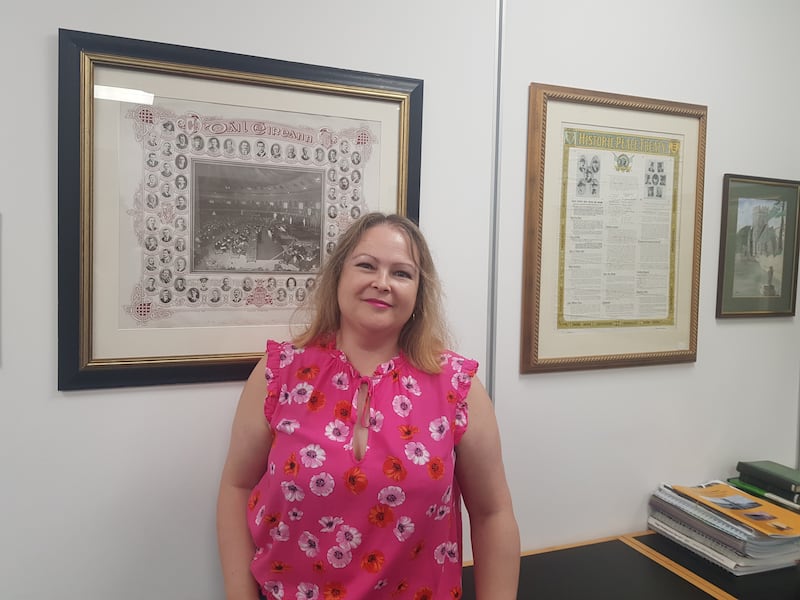For many years, nobody in the Daly family knew what had become of their long lost relative who had simply upped and vanished one day. His mother, as well as his brothers and sisters, had all died without getting any answers.
Frances Daly (50), originally from Carrickmacross, Co Monaghan, but now living in Dublin, describes using her DNA to solve this “family mystery” of her father’s uncle, who was named John Daly, as one of her proudest moments.
“He used to get remembered at various family events,” recalls Daly. “He would regularly get a decade of the rosary said for him. Everybody thought he just went off and made his fortune, but unfortunately that didn’t happen.”
It was only when Daly took an interest in tracing her family tree that she came up with answers.
“I saw him in the Census, and then I found him two years later, dead in Australia at 23 from typhoid,” she says. “I found a guy coming in from London on a boat to Perth, and I think it’s him. His name is too common to be absolutely sure.
“But if it is him, he got the whole way across Australia and then got bitten by something. He was in the sugar cane territory so there would have been regular outbreaks of diseases.”
Daly managed to find his grave in Brisbane, and also found a small article in a newspaper marking his death. The big question left for Daly and her family was why this man had travelled all the way to the other side of the world without a word to anybody.
It was only when she sent her DNA to a genealogy company, which operates by building a database and cross-referencing people’s genetic codes, that she finally “closed the circle” and got what is at least plausible explanation for what happened.
“He had two maternal aunts in New Zealand, and it seems he was going out to them,” she says. “We’ll never know for sure, but I didn’t know about the New Zealand people until I did the DNA so that kind of closed a circle for me.
“It brought great comfort to some of the older relatives to know he was buried properly and there was a priest and everything there with him. My father had a cousin who was a priest so to be able to tell him everything was done right was special.”
Daly, whose family are spread over counties Louth, Monaghan and Kildare, also unearthed relatives from Melbourne, Montana, Canada, and New Zealand through the DNA testing.
“I call them my new relatives,” she says. “It’s great to be able to show them photographs of the homestead, or the graves – we’ve some very old graves in the family – and share stories. To be able to show them, ‘this is your auntie Mary’, or whatever the case may be.
“I’ve gone off and taken photographs of fields and old houses and farmyards and sent them away to people. You can see family resemblances and traits in photographs of people going back generations too.”
A number of these people even made the long journeys back to Ireland to meet Daly and see these familial landmarks for themselves. “Sometimes the biggest connection is to be able to go and put some flowers on a grave and acknowledge somebody,” she says.
Part of the appeal of all this, Daly adds, is putting the pieces of the jigsaw together without having the picture on the box to help you along. For her, it isn’t just about what happened, but why.
“They were farmers from the country so they left for economic reasons – a chance of a better life,” she says. “Back in the day, if there was a small farmer and the eldest son got the land and there were three other sons, the others had no choice but to go.
“I have relatives who went out to mining towns in Montana. A lot of people from Carrickmacross went there for some reason. I don’t know why because there isn’t much of a mining tradition in Carrickmacross.”
Claire Bradley, a professional genealogist specialising in Irish family history, says there are “huge leaps” that can be made in tracing family trees through the use of DNA, but stresses it must be used as a compliment to paper records.
“In Ireland, we are really hampered by the fire in the Four Courts in 1922 when a lot of records were destroyed, largely Census records, but also wills and things like that,” she says. “I have gone from about 1,000 in my family tree when I started using DNA to about 4,000 now.”

All that being said, many people have raised concerns around the idea of handing their DNA over to private companies and what the implications of that could be down the road. Unsurprisingly, perhaps, Bradley dismisses much of this as “scaremongering”.
“You’re agreeing to give it over,” she says. “You can have it removed from the database if you change your mind. I think there is a lot of scaremongering in it. I think people give away a lot more information on Facebook than they do with a DNA swab.”
[ Irish ‘DNA atlas’ maps genes of the people of IrelandOpens in new window ]
Bradley says the DNA aspect of genealogy is more adept at “widening” family trees than it is at tracing backwards. This was the case for Gina Dooley (46) from Limerick who describes herself as a newcomer to all this.
About a month before the Covid-19 pandemic hit Irish shores, her grandmother died. During the grieving process, a lot of old photographs were taken out and pored over as the family took stock.
It was when she looked at a photograph of her great-grandmother that she was stopped in her tracks. “I was struck by how I knew nothing about this woman, yet she looked so much like me and my mother,” she says. So, she “started digging”, and later did the DNA test.
She didn’t uncover any “terrible secrets” and describes her family history as a normal one – “regular peasant farmers” – but remarks that “building a picture of the time they lived in and the town they came from makes them feel more real and me feel more grounded”.
One particular story of a second cousin she discovered in Australia stands out. After they made contact, the man told her about an uncle of his with whom he had lived as a child. She then went to the Military Archives to find out more about him.
“I don’t know how to describe the feeling of sitting in the Military Archive holding pages that he wrote,” she says. “I never met this man – he was my grandmother’s uncle – but it was like a piece of him was still alive.
“I could share that with James in Australia, and he could relay to me things he remembered of this man, and how he used to go off on a rant about Ian Paisley. James was five years old, and he didn’t know who Ian Paisley was, but that is all he remembers of this man.”










